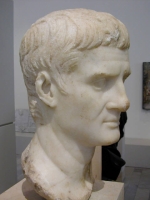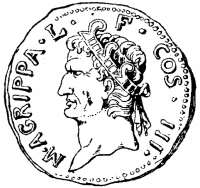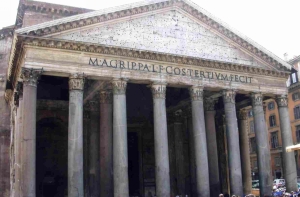


Marcus Agrippa: unsung water-man
The Roman water system in the early empire can be said to be the product of one man: Marcus Agrippa. Though he constructed only three of the six aqueducts existing at that time, he so improved and extended the others that his contributions may have outweighed the original construction. A careful reading of Frontinus suggests that he believed that Rome had Agrippa to thank for the good state of the aqueducts. We find ample mention of Agrippa's building activities in the ancient sources, for example in Strabo (5.3.8 and 13.1.19), Pliny (Nat. His. 36.102, 104-108 and 121) and Dio (49.43, 53.27, 54.29, 55.8 and 56.24).Agrippa's life until his friendship with Octavius is obscure (Reinhold, 1965:1). We know nothing of his parents and his early days. Agrippa was likely slightly older than Octavius. It is surprising that Agrippa, belonging to one of the most humble gens, the Vipsania, was educated with Octavius and became his closest friend by the age of 17. Wright (1937:9) hazards a controversial guess, that Agrippa's father was in reality Julius Caesar. As evidence, he points out that Caesar led a loose life, and that if Caesar was indeed the father, this would explain why Agrippa received an education usually reserved for rich men's sons. It would also explain why Caesar had Agrippa as well as Octavius accompany him on his Spanish expedition, and why both men were send to study at Apollonia together. It is also interesting to note that Agrippa usually dropped his middle name, and Herod named his grandson after him, calling his grandson Marcus Julius Agrippa. Certainly Marcus Agrippa had Caesars drive and energy.
Agrippa's extraordinary range of accomplishments and his evident competence indicates that perhaps Octavius would not himself been so accomplished were it not for Agrippa. It was perhaps Agrippa, and not Augustus, who "found Rome brick and left it marble". Agrippa seemed to have been a self-effacing man, and besides, it was normal practice for an emperor to take credit.. Among his many accomplishments are the reconditioning of the sewers, building public bathes in the Campus Martius, building the Pantheon and setting up the naval base Portus Julius at Cumae. It is perhaps suggestive of the respect in which he was held, that Hadrian had the Pantheon inscription bearing Agrippa's name installed when he rebuilt it. He also established a permanent Roman navy and put an end to the Mediterranean pirate bands, commanded the fleet at Actium and fought in nearly every major battle of his time. Agrippa was also responsible for the construction of two aqueducts, an accomplishment matched by no other individual, and apparently at his own expense see Dio Cassius (49.43.1). Though his involvement with the aqueducts is well documented, further research is still needed to assess quantitatively as well as qualitatively exactly what his contribution was, not only in Rome, but wherever he contributed to the water supply. Certainly there is evidence that he was an innovator as well as an administrator.
In a sense, the Empire's aqueduct system was an extension of Agrippa's ideas. The later aqueducts offered some innovation in construction, but the system within the city remained very much the same as it was in Agrippa's day. This is not to say that branches were not added, or water was not delivered to dry areas and baths; on the contrary, the system expanded beyond control. However, the methods of storage, delivery and measurement were those known before Agrippa or introduced by him. We find much evidence of Agrippa's building activities (Strabo 5.3.8 and 13.1.19; Pliny Nat. His. 36.102, 104-108 and 121; Dio 49.43, 53.27, 54.29, 55.8 and 56.24). However, his water planning deserves more recognition. He built the foundation for imperial administration of Rome's aqueduct system, which was never entirely superseded. The city's needs for water increased with steady growth and new tastes in monumental architecture that used water more, and more for decorative purposes such as fountains. Later lines introduced by Claudius and Trajan were of much higher elevation and greater capacity but while they distributed water all over Rome, our evidence concerning their delivery indicates that they functioned as general and not specialized lines serving a wide variety of uses. While the Claudian aqueducts dwarfed all earlier lines in their height and volume (Pliny HN 36.122), quickly becoming the master part of the entire system, they and the Aqua Traiana appear to have been built to provide an overall supplement to existing aqueducts rather than to replace the distribution plan Agrippa had devised (Evans, 1982:411).
A final accomplishment of Agrippa's worth mentioning: Frontinus credits him with the invention of a new system of measuring water, the quinaria. This is the system that continued to be used for at least several hundred years. Though it is inadequate by today's standards, it is probable that it was better than the previous system.
From the thesis of Evan J. Dembskey on The aqueducts of Ancient Rome